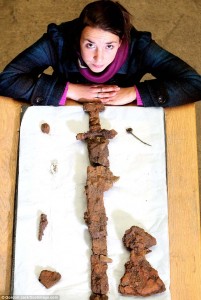 Archaeologists excavating the peninsula of Ardnamurchan in Scotland have discovered the first fully intact Viking boat burial site ever found in the mainland UK. The grave is five feet wide and almost 17 feet long, the size of boat itself which has long since decayed. The only remnants of it are 200 metal rivets that once held the timbers together and some slivers of wood still attached to rivets. The shape of the boat, however, with its pointed prow and stern, was pressed in the ground over the centuries and is still clearly visible. Experts have given the site a preliminary date of 1000 A.D., but we won’t know the exact date until the remains are radiocarbon dated.
Archaeologists excavating the peninsula of Ardnamurchan in Scotland have discovered the first fully intact Viking boat burial site ever found in the mainland UK. The grave is five feet wide and almost 17 feet long, the size of boat itself which has long since decayed. The only remnants of it are 200 metal rivets that once held the timbers together and some slivers of wood still attached to rivets. The shape of the boat, however, with its pointed prow and stern, was pressed in the ground over the centuries and is still clearly visible. Experts have given the site a preliminary date of 1000 A.D., but we won’t know the exact date until the remains are radiocarbon dated.
The Viking, of whom only a few bone fragments and teeth remain, was buried in a traditional pagan Norse warrior ritual: laid to rest on his boat with his shield on top of him, then covered in stones. Buried in the grave with him archaeologists found a sword, a battle-axe, a spear, the shield and a number of other artifacts including a bronze drinking horn, a bronze Irish ring-pin and a Norwegian whetstone. The range, variety and quality of grave goods indicate that the warrior was widely traveled and extremely well-off.
Viking boat burials in general were reserved for the most important personages destined for Valhalla. Few of them survive intact because as befits a naval theme, chosen burial sites were often coastal and thus highly susceptible to flooding and erosion. Some of them have been found on Scottish islands — the Norse were settled and living in Orkney and Shetland by the mid-800s — but all the Viking burials found on mainland Britain have been found in traditional Christian cemeteries.
The Ardnamurchan Transitions Project, a collaborative team of archaeologists from Manchester and Leicester universities, plus private archaeology firm CFA Archaeology and volunteer non-profit Archaeology Scotland, has been excavating the Ardnamurchan every summer for six years focusing their research on periods of social transition, for instance the shift from Bronze Age to Iron Age.
Hannah Cobb, an archaeologist from the University of Manchester who is co-director of the excavation, said: “We had spotted this low mound the previous year, but said firmly that it was probably just a pile of field clearance rocks from comparatively recent farming.
“When we uncovered the whole mound, the team digging came back the first night and said it looked quite like a boat.
“The second night they said: ‘It really does look like a boat.’ The third night they said: ‘We think we really do have a boat’. It was so exciting, we could hardly believe it.”
They recovered fragments of an arm bone and several teeth, which should allow analysis of radioactive isotopes and reveal where the man came from.
The fragments of wood clinging to the rivets should reveal what trees were felled for his ship, and possibly where it was built.
The beautiful and rugged coastal Highlands of Ardnamurchan have long since appealed to local populations as burial grounds. There are cairns dating back to the Stone Age 6,000 years ago in the area. Perhaps it was specifically selected as a final resting point for a highly respected Viking figure, or perhaps he died in transit. Its completeness, artifact remains, pagan ritual and location on the British mainland provide a rich field of material that archaeologists expect will illuminate post-raid Viking life in Scotland.
The artifacts are now being studied by team members at the universities of Manchester and Leicester. They will be cleaned and eventually put on display at a museum to be determined. Of course the British Museum is interested, but the locals think this spectacular find should be exhibited in Scotland where it was found.
Extremely relevant to my interests. Will subscribe to your newsletter.
For an eyewitness and his account of a (‘russian’) viking ship burial in AD 921, check:
http://en.wikipedia.org/wiki/Ahmad_ibn_Fadlan
:hattip:
… A by far better -and more complete- version is this one:
http://www.uib.no/jais/v003ht/03-001-025Montgom1.htm
:hattip:
What an incredible find!
It should absolutely remain in Scotland where it was found but, also a replacement mound should be placed in the exact location out of respect for the site and the dead.